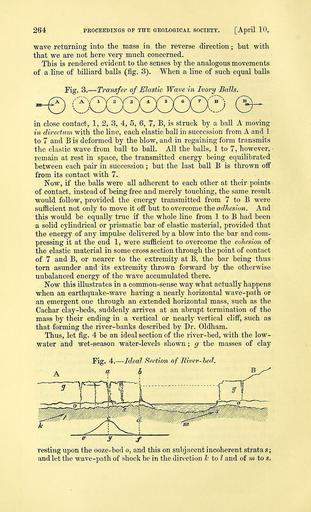MAKE A MEME
View Large Image

| View Original: | The_Quarterly_journal_of_the_Geological_Society_of_London_(12512912173).jpg (1941x3200) | |||
| Download: | Original | Medium | Small | Thumb |
| Courtesy of: | commons.wikimedia.org | More Like This | ||
| Keywords: The Quarterly journal of the Geological Society of London (12512912173).jpg 264 <br> PROCEEDINGS OF THE GEOLOGICAL SOCIETY April 10 <br> wave returning into the mass in the reverse direction ; but with <br> that we are not here very much concerned <br> This is rendered evident to the senses by the analogous movements <br> of a line of billiard balls fig 3 When a line of such equal balls <br> Pig 3 ” Transfer of Elastic Wave in Ivory Balls <br> in close contact 1 2 3 4 5 6 7 B is struck by a ball A moving <br> in directum with the line each elastic ball in succession from A and 1 <br> to 7 and B is deformed by the blow and in regaining form transmits <br> the elastic wave from ball to ball All the balls 1 to 7 however ˘ <br> remain at rest in space the transmitted energy being equilibrated <br> between each pair in succession ; but the last ball B is thrown off <br> from its contact with 7 <br> Now if the balls were all adherent to each other at their points <br> of contact instead of being free and merely touching the same result <br> would follow provided the energy transmitted from 7 to B were <br> sufficient not only to move it off but to overcome the adhesion And <br> this would be equally true if the whole line from 1 to B had been <br> a solid cylindrical or prismatic bar of elastic material provided that <br> the energy of any impulse delivered by a blow into the bar and com- <br> pressing it at the end 1 were sufficient to overcome the cohesion of <br> the elastic material in some cross section through the point of contact <br> of 7 and B or nearer to the extremity at B the bar being thus <br> torn asunder and its extremity thrown forward by the otherwise <br> unbalanced energy of the wave accumulated there <br> Now this illustrates in a common-sense way what actually happens <br> when an earthquake-wave having a nearly horizontal wave-path or <br> an emergent one through an extended horizontal mass such as the <br> Cachar clay -beds suddenly arrives at an abrupt termination of the <br> mass by their ending in a vertical or nearly vertical cliff such as <br> that forming the river-banks described by Dr Oldham <br> Thus let fig 4 be an ideal section of the river-bed with the low- <br> water and wet-season water-levels shown ; g the masses of clay <br> Fig 4 ” Ideal Section of Biver-hed <br> resting upon the ooze-bed o and this on subjacent incoherent strata s; <br> and let the wave-path of shock be in the direction Tc to I and of m to s 34985273 108770 51125 Page 264 Text v 28 http //www biodiversitylibrary org/page/34985273 1872 Geological Society of London Biodiversity Heritage Library The Quarterly journal of the Geological Society of London v 28 1872 Geology Periodicals Smithsonian Libraries bhl page 34985273 dc identifier http //biodiversitylibrary org/page/34985273 smithsonian libraries Information field Flickr posted date ISOdate 2014-02-14 Check categories 2015 August 26 CC-BY-2 0 BioDivLibrary https //flickr com/photos/61021753 N02/12512912173 2015-08-27 10 02 41 cc-by-2 0 PD-old-70-1923 The Quarterly journal of the Geological Society of London 1872 Photos uploaded from Flickr by Fæ using a script | ||||